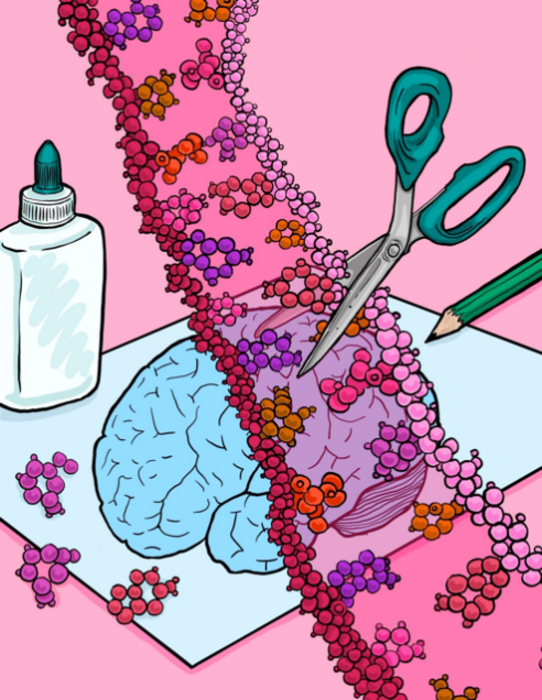Numerous sites in the brain where RNA is altered over the course of a person’s lifespan through a process known as adenosine-to-inosine (A-to-I) editing have been identified by Mount Sinai researchers.
 A-to-I editing functions much like a large-scale cut and paste type of edit on pre-mRNA sequences, driven by ADAR enzymes. In the brain, these natural modifications have diverse effects on gene expression and protein function throughout neurodevelopment. Image Credit: Jessica Johnson
A-to-I editing functions much like a large-scale cut and paste type of edit on pre-mRNA sequences, driven by ADAR enzymes. In the brain, these natural modifications have diverse effects on gene expression and protein function throughout neurodevelopment. Image Credit: Jessica Johnson
These discoveries open up important new perspectives on the cellular and molecular mechanisms underlying brain development and how they relate to both health and disease.
The scientists described how the rate of RNA editing in the brain rises with age in a study that was published in Cell Reports. This finding has implications for analyzing the pathology of altered A-to-I editing in a variety of neurodevelopmental and ageing disorders.
Our work provides more nuanced and accurate insights into the contribution of RNA modifications by A-to-I editing during human brain development.”
Michael Breen, PhD, Study Senior Author and Assistant Professor, Psychiatry, and Genetics and Genomic Sciences, Icahn School of Medicine at Mount Sinai
Dr Breen added, “The field has already identified millions A-to-I sites in the brain, which has made it particularly challenging to determine which of these are likely to be physiologically important. We narrowed this down to about 10,000 sites with potential functional roles from early fetal development through advanced aging. By providing an atlas of these sites, we’ve opened the door to further understand brain neurodevelopment through the lens of A-to-I RNA modifications.”
Dr Breen is also a member of the Seaver Center for Autism Research and Treatment.
Although DNA stores the genetic code for people and other living things, it is RNA that actually executes DNA’s instructions to produce functional proteins. The RNA can accumulate modifications that change how a protein eventually behaves. These particular A-to-I modifications are introduced by a family of ADAR enzymes.
A few of these changes are known to control synaptic transmission and neuronal communication in the brain during early fetal development, playing crucial physiological roles.
This research demonstrates that millions of unique edits to RNA accumulate in the brain over the course of the human lifespan, and that these modifications are likely to have functional effects as we age.
More than 800 people’s brain RNA-sequence data were obtained and compiled by the Mount Sinai study. From the very first embryonic progenitor cells to functionally differentiated brain tissue from centenarians, these data spanned all stages of prenatal and postnatal development.
This comprehensive analysis allowed researchers to create a model that, for the first time, shows how A-to-I editing changes over the course of a lifetime. The model predicts that edited RNAs are more prevalent in the adult brain and that, during fetal development, unedited RNAs are expressed more frequently and could even be translated into proteins.
Dr Breen stated, “This means that during older age there is generally a higher editing rate and frequency of A-to-I editing occurring, including stabilizing RNA structures and modulating the way RNAs interact with microRNAs.”
His study group also discovered that a portion of these A-to-I sites induce RNA recoding, or new amino-acid substitutions, into the brain’s protein-coding region. Given that RNA recoding has direct functional and/or structural impacts on proteins, this discovery is particularly significant.
The Mount Sinai researchers also looked into how genetic variation might account for some of the variations in A-to-I editing as people age. They discovered that thousands of sites have substantially varying editing levels based on distinct genetic variants because editing sites are tightly regulated throughout early fetal development.
During postnatal development, this disparity becomes more equal. The dynamically controlled locations discovered by researchers offer a wide range of opportunities for future study to manipulate fundamental pathways of early brain development using A-to-I editing from a basic science perspective.
A-to-I editing is impaired in brain tissue from people with neurodevelopmental problems, according to earlier research by Dr Breen, whose team focuses at the interface of functional genomics, computational biology, and neuroscience.
“This work provides us with immediate avenues for dissecting the pathological implications of altered A-to-I editing across a range of neurodevelopmental and aging disorders. It is clearer now than ever that elucidating the dynamic regulation of RNA editing can offer unique insights into their role in promoting health as well as disease,” further added Dr Breen.
Source:
Journal references:
- Cuddleston, W. H., et al. (2022). Spatiotemporal and genetic regulation of A-to-I editing throughout human brain development. Cell Reports. doi.org/10.1016/j.celrep.2022.111585
- Breen, M. S., et al. (2022). Global landscape and genetic regulation of RNA editing in cortical samples from individuals with schizophrenia. Nature Neuroscience. doi.org/10.1038/s41593-019-0463-7